
The Subramaniya Swamy Temple, Tiruchendur is an ancient Hindu temple dedicated to Murugan (Kartikeya). It is second among six abodes of Murugan situated in Tamil Nadu, India. It is located in the eastern end of the town Tiruchendur in the district of Thoothukudi, Tamil Nadu, India. It is 40 km from Thoothukudi, 60 km south-east of Tirunelveli and 75 km north-east of Kanyakumari. The temple complex is on the shores of Bay of Bengal.
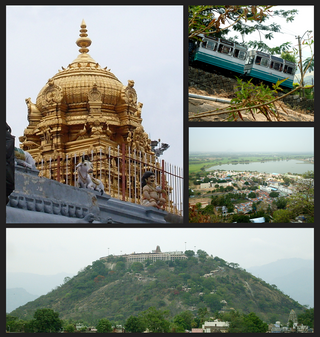
Palani (Tamil:[paɻani], is a town and a taluk headquarters in Dindigul district of the western part of Tamil Nadu state in India. It is located about 106 kilometres south-east of Coimbatore and 122 kilometres north-west of Madurai, 67 kilometres from Kodaikanal. The Palani Murugan Temple or Arulmigu Dhandayuthapani Swamy Temple, dedicated to Murugan is situated on a hill overlooking the town. The temple is visited by more than 7 million pilgrims each year. As of 2011, the town had a population of 292301 which makes it the second largest town in the district after Dindigul.

Temple cars or Temple chariots are used to carry representations of Hindu gods around the streets of the temple on festival days. These chariots are generally manually pulled by the devotees of the deity.

Tiruchendur is a municipality located in Thoothukudi District, Tamil Nadu, India. It is home to the Arulmigu Subramaniya Swamy Temple, which is one of the Six Abodes of Murugan. It is also the only abode of Murugan that is situated on a seashore.

The Dutch–Portuguese War was a global armed conflict involving Dutch forces, in the form of the Dutch East India Company, the Dutch West India Company, and their allies, against the Iberian Union, and after 1640, the Portuguese Empire. Beginning in 1598, the conflict primarily involved the Dutch companies and fleet invading Portuguese colonies in the Americas, Africa, and the East Indies. The war can be thought of as an extension of the Eighty Years' War being fought in Europe at the time between Spain and the Netherlands, as Portugal was in a dynastic union with Spain after the War of the Portuguese Succession, for most of the conflict.

Muhammad Yusuf Khan was a commandant of the British East India Company's Madras Army. He was born in a Tamil Vellalar clan family in a village called Panaiyur in British India, what is now in Nainarkoil Taluk, Ramanathapuram District of Tamil Nadu, India. He converted to Islam and was named Muhammad Yusuf Khan. He was popularly known as Khan Sahib when he became a ruler of Madurai. He became a warrior in the Arcot troops, and later a commandant for the British East India Company troops. The British and the Arcot Nawab employed him to suppress the Polygar uprising in South India. Later he was entrusted to administer the Madurai country when the Madurai Nayak rule ended.
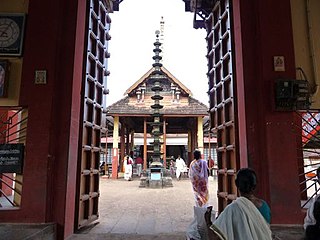
Haripad is a Municipality in Onattukara region of Alappuzha District, Kerala, India located between Alappuzha and Kollam on the National Highway 66. Haripad is bordered on the east by Pallippad, Veeyapuram and Karuvatta to the north, Kumarapuram and Karthikappally to the West, and on the south by Cheppad. It is known as the land of art, artists, land of snake boats, land of music, dance and drama. It is also popularly known as Kshetranagari in which Haripad Temple being the chief one among them.One of the largest thermal power plants in Kerala, the Rajiv Gandhi Combined Cycle Power Plant run by the NTPC, is situated at Haripad.

Dutch Ceylon was a governorate established in present-day Sri Lanka by the Dutch East India Company. Although the Dutch managed to capture most of the coastal areas in Sri Lanka, they were never able to control the Kingdom of Kandy located in the interior of the island. Dutch Ceylon existed from 1640 until 1796.
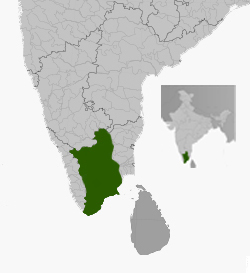
The Madurai Nayaks were a Telugu dynasty who ruled most of modern-day Tamil Nadu, India, with Madurai as their capital. The Madurai Nayaks had their origins in the Balija warrior clans of present-day Andhra Pradesh. The Nayak reign which lasted for over two centuries from around 1529 to 1736 was noted for its achievements in arts, cultural and administrative reforms, revitalization of temples previously ransacked by the Delhi Sultans, and the inauguration of a unique architectural style.
Kumaragurupara Desikar or Kumaraguruparar was a poet and Saivite ascetic connected with the Dharmapuram Adheenam.
Nakkīraṉãr, sometimes spelled Nakkirar or Nakkiranar, was a post-Sangam era Tamil poet. He is credited with the devotional poem to the Hindu god Murugan in the Pattuppāṭṭu anthology, titled Tirumurukāṟṟuppaṭai. In the historic Tamil tradition, he is believed to have also authored a second poem in the Sangam collection titled Neṭunalvāṭai, as well as a detailed commentary on Iraiyanar Akapporul. However, according to the Tamil literature scholar Kamil Zvelebil, the Tirumurukāṟṟuppaṭai and the Neṭunalvāṭai were likely authored by two different Nakkirar, and Nakkīraṉãr and the older Nakkīrar were different individual. It is uncertain as to which century Nakkiranar lived, much like the chronology of the Sangam literature. Scholars variously place his works between 3rd and 8th century CE, with Zvelebil suggesting late classical.

The Nayaks of Gingee (Senji) were rulers of the Gingee principality of Tamil Nadu between 16th to 18th century CE. They were subordinates of the imperial Vijayanagara emperors, and were appointed as provincial governors by the Vijayanagar Emperor who divided the Tamil country into three Nayakships viz., Madurai, Tanjore and Gingee. Later, after the fall of the Vijayanagara's Tuluva dynasty, the Gingee rulers declared independence. While they ruled independently, they were sometimes at war with the Tanjore neighbors and the Vijayanagara overlords later based in Vellore and Chandragiri. The Gingee Nayaks had their origins in the Balija Merchant clans of present-day Andhra Pradesh.

Kartikeya, also known as Skanda, Subrahmanya, Shanmukha and Murugan, is the Hindu god of war. He is the son of Shiva and Parvati and the brother of Ganesha.
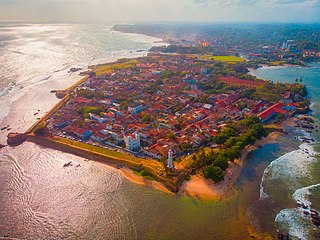
Galle Fort, in the Bay of Galle on the southwest coast of Sri Lanka, was built first in 1588 by the Portuguese, then extensively fortified by the Dutch during the 17th century from 1649 onwards. It is a historical, archaeological and architectural heritage monument, which even after more than 432 years maintains a polished appearance, due to extensive reconstruction work done by Archaeological Department of Sri Lanka.

Dutch Malabar also known by the name of its main settlement Cochin, were a collection of settlements and trading factories of the Dutch East India Company on the Malabar Coast between 1661 and 1795, and was a subdivision of what was collectively referred to as Dutch India. Dutch presence in the Malabar region started with the capture of Portuguese Quilon, expanded with the Conquest of Malabar (1658-1663), and ended with the conquest of Malabar by the British in 1795. They possessed military outposts in 11 locations: Alleppey, Ayacotta, Chendamangalam, Pappinivattom, Ponnani, Pallipuram, Cranganore, Chetwai, Cannanore, Cochin, and Quilon.

Irattai Tirupati Temples refer to two temples of the Nava Tirupati, namely, the Devapiran temple and Aravindalochanar temple, which are dedicated to Vishnu. They are part of the nine "Divya Desams" located along the Tiruchendur-Tirunelveli route in Tamil Nadu, India on the banks of Thamiraparani river. The two temples are located adjacent to each other. All nine temples are part of the 108 temples of Vishnu revered by the 12 poet saint Alvars. The Irattai Tirupati is a Ketu Sthalam, sacred to the deity Ketu. Constructed in the Dravidian style of architecture, the temples are dedicated to Vishnu who is worshipped as Devapiran and Aravindalochanar and Lakshmi as Varagunavalli and Karuthadankanni.

The Makara Nedunkuḻaikathar Temple is one of the Nava Tirupathi, nine Hindu temples dedicated to Vishnu located Thenthiruperai along Tiruchendur-Tirunelveli route, Tamil Nadu, India in the southern bank of Thamiraparani river. It is located 5 km from Alvar Thirunagari All these 9 temples are classified as Divya Desams, the 108 temples of Vishnu revered by the 12 poet saints, or Alvars. The temple is referred to as Sukra sthalam, a location for the planet deity, Sukra. Constructed in the Dravidian style of architecture, the temple is glorified in the Nalayira Divya Prabandham, the early medieval Tamil canon of the Alvar saints from the 6th–9th centuries CE. It is one of the 108 Divya Desams dedicated to Vishnu, who is worshipped as Makara Nedunkuḻaikathar and his consort Lakshmi as Tiruperai Nachiyar.
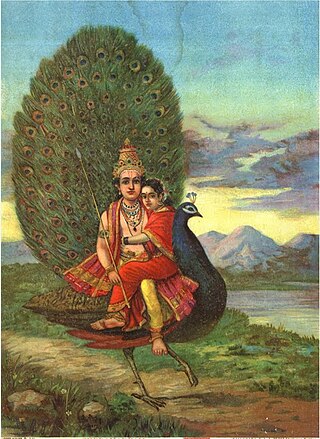
Valliamman Cave Temple is a Hindu temple dedicated to the goddess Valli, consort of Murugan (Kartikeya), situated in the northeast corner of Thiruchendur Murugan Temple. In early days, the temple was situated very near to the sea shore and now due to the construction of pathways the sea get backed to some extent. It is a cave of the sandal mountain remainings.
Elelasingan, also known as Elelasingan Chettiyar, Elela and Alara, was a Tamil merchant who lived in Mylapore, by the shores of the Pallava Kingdom, trading between India and Ceylon. He is best known as the contemporary, friend, and disciple of the celebrated Tamil poet and philosopher Valluvar.
















